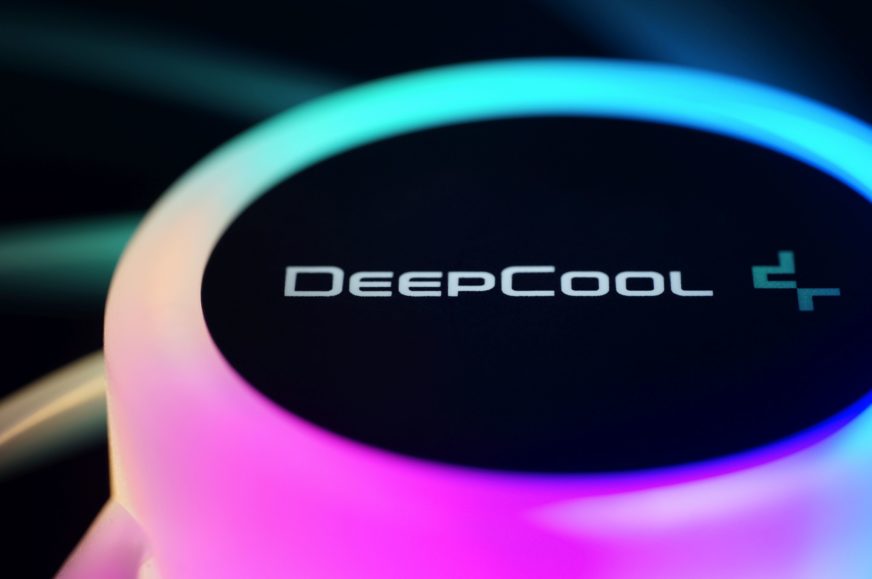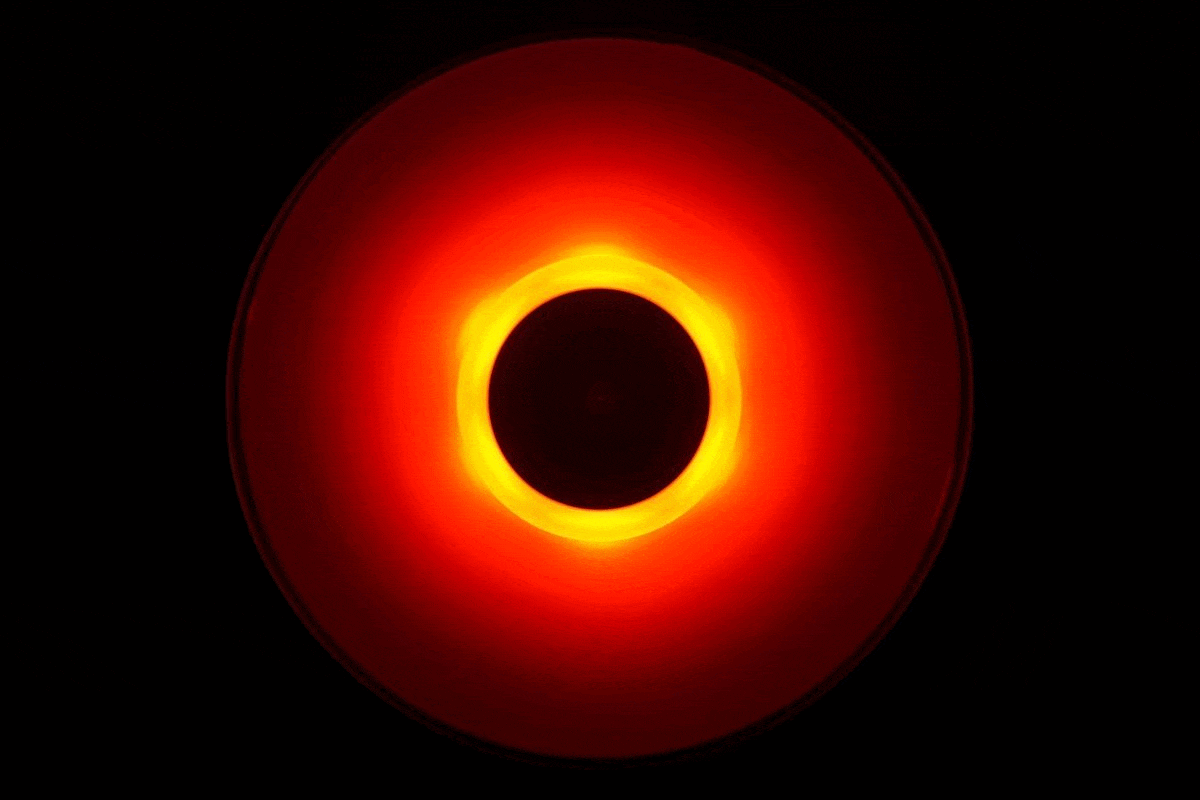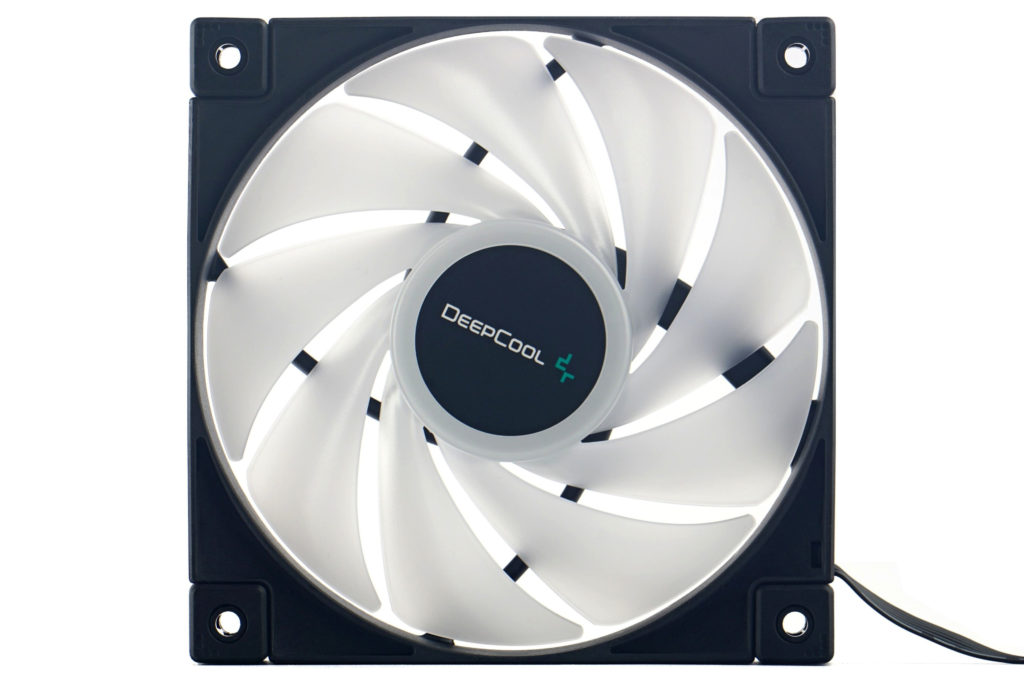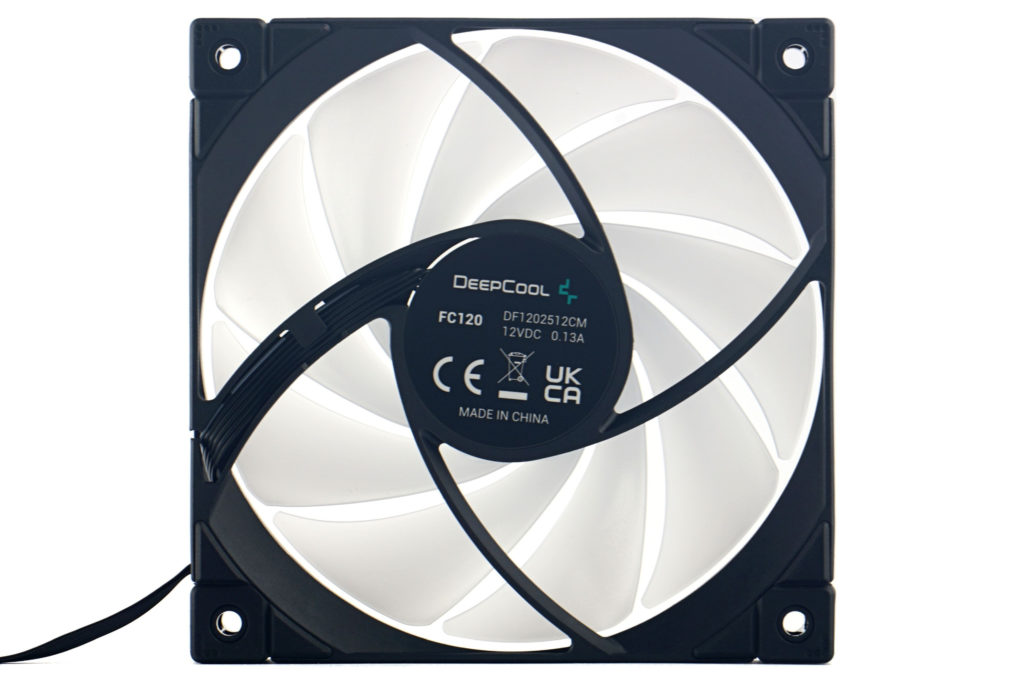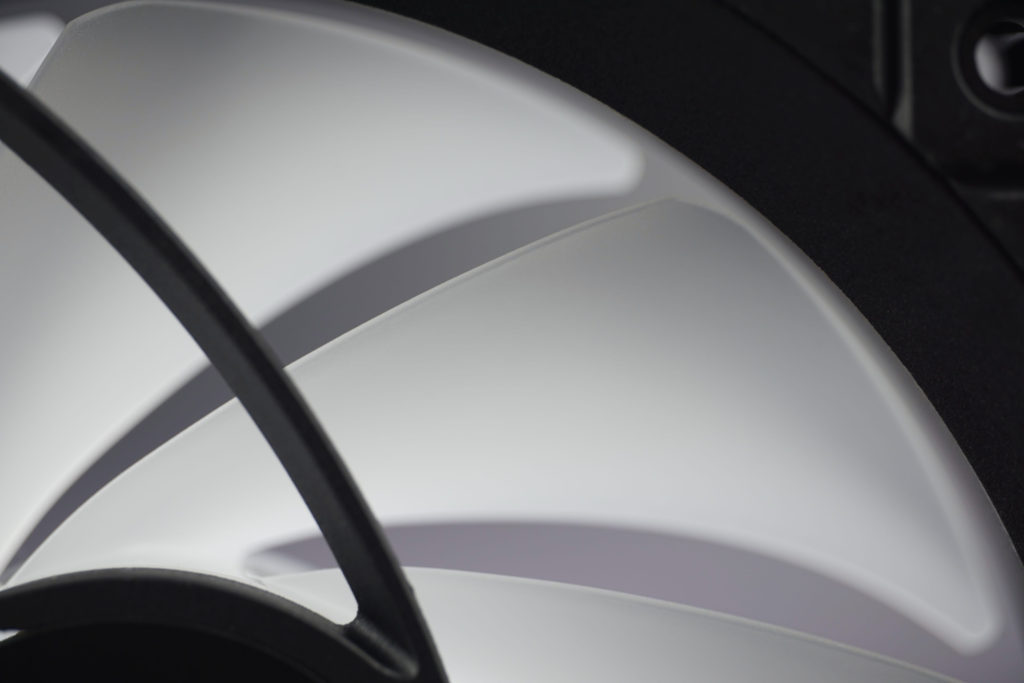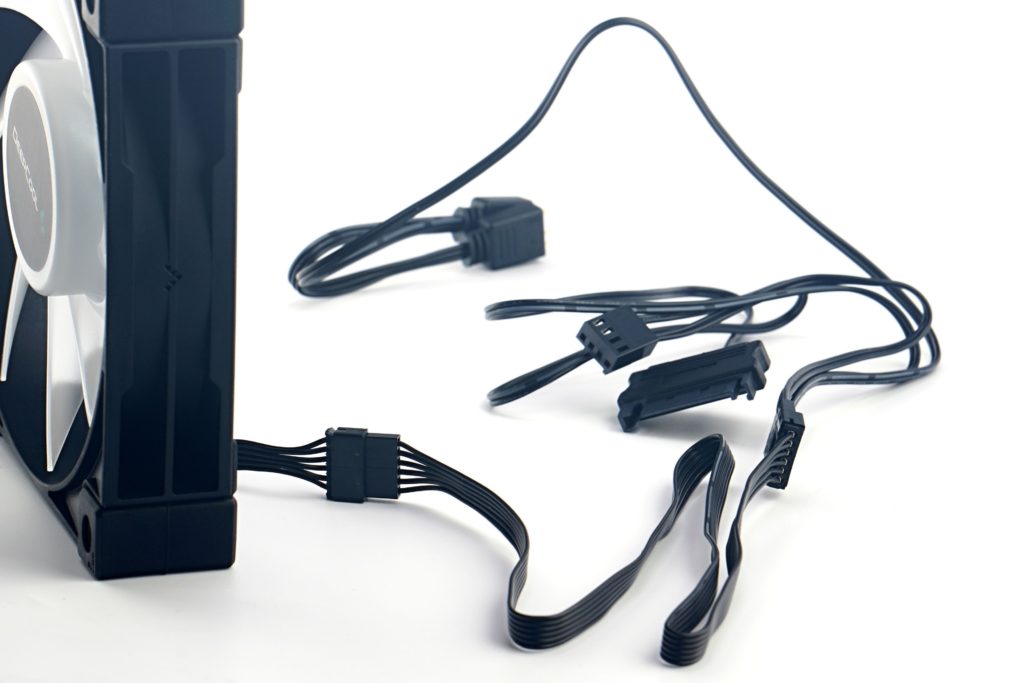DeepCool FC120 in detail
The biggest advantage, but at the same time the biggest disadvantage of the DeepCool FC120 fan are its long and overall large blades, whose area exceeds that of competing models. Among illuminated fans, this one represents one of the most efficient solutions with ARGB LEDs, in optimal conditions. However, it is important to notice its downsides, which are a side effect of the chosen rotor design.
The key parameter for achieving the highest possible airflow with fans is the blade surface area. Of course, it’s more complicated than that and even a fan with a smaller blade area can achieve a higher airflow. A number of design details affect the end result, from the shape (of the frame as well), the inclination, but also the rigidity of the blades.
But the advantage of the DeepCool FC120 is precisely that it has larger blades than other 120mm format fans, even with the very small vertical gaps that are between them. But for these parameters alone, there are situations where the DeepCool FC120 delivers top-notch results. You won’t find many fans among the illuminated fans (is there any? Only time will tell…) that are more efficient for most scenarios.
Unlike many other fans, the FC120’s blades start from a fairly sharp curve. This makes the leading and trailing edges longer, which in the final sum then gives more surface area per blade. Compared to, for example, the Gigabyte Aorus 120 ARGB (which is also a 120mm fan with nine blades) quite significantly so.
In order for the blades to be so large and form such a significant part of the overall cross-section, the area of the motor housing is also smaller. Compared to the aforementioned Aorus 120 ARGB fan, it’s roughly 23.4 % smaller, but again, DeepCool hasn’t pushed it to extremes. The Gelid Zodiac’s housing has a 13 % smaller cross-section (than the DeepCool FC120 fan). It is important that the fan centre is sufficiently robust for the needs of the fan. As an interesting side note, the cross section of the FC120 motor housing is 1615 mm2, which is approximately 15.5 % of the total cross section.
Many things, including cooling performance, are dependent on the rigidity of the blades. The latter is, in this case, below average. The material used is PBT, which is common for this type of fans, but its thickness is only up to 1.5 mm at the thickest point. Combined with the geometry of the FC120 with its rather wide tips and narrow blade stems, there is naturally excessive undulation of the torque, which I will address in some detail in the final chapter, when evaluating the sub-features of this fan.
The stator struts are properly aerodynamic, with a rounded design, and they are angled to the rotor on the narrower side. As a detail, it’s still worth pointing out the solid anti-vibration pads. These are not adhesive (as is usual), but are a solid part of the corners, and yet they are also softer (with a hardness of around 40 Shore), so they can absorb vibrations from this rotor quite effectively.
And one more caveat about power supply. The fan has only a shorter (170 mm) 6-pin cable (for both the motor and the ARGB LEDs), which counts with connection to a hub. However, the package also includes an adapter to connect to the motherboard, i.e. with two connectors on the end (4-pin for PWM and 3-pin for ARGB LED). However, you must also have a SATA connector connected to power the lighting.
| Brand and model of fan | Paper specicifations * | Price [EUR] | ||||||||
| Format (and thickness) in mm | Connecting | Speed [rpm] | Airflow [m3/h] | Static pressure [mm H2O] | Noise level [dBA] | Bearings | MTBF [h] | |||
| Motor | RGB LED | |||||||||
| DeepCool FC120 | 120 (25) | 6-pin (PWM) | 6-pin (5 V) | 500–1800 | 105.19 | 1.83 | 28.0 | hydrodynamic | N/A | 20 |
| Nidec Servo Gentle Typhoon D1225C (2150/12) | 120 (25) | 4-pin (PWM) | N/A | 2150 | 117.23 | 2.87 | 30.0 | ball | 100 000 | 20 |
| BeQuiet! Shadow Wings 2 (BL085) | 120 (25) | 4-pin (PWM) | N/A | 1100 | 65.41 | 0.82 | 15.9 | rifle | 80 000 | 15 |
| Noctua NF-A12x25 PWM | 120 (25) | 4-pin (PWM) | N/A | 450–2000 | 102.10 | 2.34 | 22.6 | SSO2 | 150 000 | 28 |
| Corsair AF120 Elite (black) | 120 (25) | 4-pin (PWM) | N/A | 400–1850 | 18.52–100.41 | 0.09–1.93 | 31.5 | fluid | N/A | 24 |
| Cooler Master MasterFan SF120M | 120 (25) | 4-pin (PWM) | N/A | 650–2000 | 105.33 | 2.40 | 5.5–22.0 | ball | 280 000 | 33 |
| Akasa Alucia SC12 | 120 (25) | 4-pin (PWM) | N/A | 500–2000 | 95.65 | 1.94 | 33.1 | hydrodynamic | N/A | 12 |
| BeQuiet! Silent Wings Pro 4 (BL098) | 120 (25) | 4-pin (PWM) | N/A | 3000 | 142.50 | 5.31 | 36.9 | fluid | 300 000 | 32 |
| Thermalright X-Silent 120 | 120 (25) | 3-pin (DC) | N/A | 1000 | 61.31 | N/A | 19.6 | fluid | 50 000 | 5 |
| Fractal Design Aspect 12 RGB PWM | 120 (25) | 4-pin (PWM) | 3-pin (5 V) | 500–2000 | 22.09–95.14 | 0.23–2.34 | 10.0–33.2 | rifle | 90 000 | 16 |
| BeQuiet! Silent Wings 3 (BL066) | 120 (25) | 4-pin (PWM) | N/A | 1450 | 85.80 | 1.79 | 16.4 | fluid | 300 000 | 21 |
| Gelid Zodiac | 120 (25) | 4-pin (PWM) | 3-pin (5 V) | 700–1600 | 111.29 | 1.47 | 35.0 | hydrodynamic | N/A | 10 |
| Fractal Design Dynamic X2 GP-12 PWM | 120 (25) | 4-pin (PWM) | N/A | 500–2000 | 148.83 | 0.51–2.30 | 10.0–32.2 | rifle | 100 000 | 12 |
| BeQuiet! Pure Wings 2 (BL039) | 120 (25) | 4-pin (PWM) | N/A | 1500 | 87.00 | 1.25 | 19.2 | rifle | 80 000 | 11 |
| Gigabyte Aorus 120 ARGB | 120 (25) | 4-pin (PWM) | 3-pin (5 V) | 800–1700 | 31.47–69.40 | 0.37–1.48 | 7.3–28.6 | sleeve | 73 500 | 25 |
| Arctic BioniX P120 A-RGB | 120 (30) | 4-pin (PWM) | 3-pin (5 V) | 400–2300 | 81.55 | 2.10 | 33.4 | fluid | N/A | 21 |
| Akasa OTTO SF12 | 120 (25) | 4-pin (PWM) | N/A | 0–2000 | 164.84 | 3.59 | 7.1–31.7 | ball | 80 000 | 22 |
| Cooler Master SickleFlow 120 ARGB | 120 (25) | 4-pin (PWM) | 3-pin (5 V) | 680–1800 | 105.34 | 2.50 | 8.0–27.0 | rifle | 160 000 | 15 |
| Alphacool SL-15 PWM | 120 (15) | 4-pin (PWM) | N/A | 600–1800 | 71.40 | 1.20 | 32.0 | ball | 50 000 | 11 |
| Arctic BioniX F120 | 120 (25) | 4-pin (PWM) | N/A | 200–1800 | 117.00 | 2.10 | 20.0 | fluid | N/A | 10 |
| SilverStone SST-AP123 | 120 (25) | 3-pin (DC) | N/A | 1500 | 96.84 | 1.46 | 23.8 | fluid | 50 000 | 25 |
| Noctua NF-P12 redux-1700 PWM | 120 (25) | 4-pin (PWM) | N/A | 400–1700 | 120.20 | 2.83 | 25.1 | SSO | 150 000 | 13 |
| SilentiumPC Fluctus 120 PWM | 120 (25) | 4-pin (PWM) | N/A | 300–1800 | N/A | N/A | N/A | fluid | 100 000 | 12 |
| MSI MEG Silent Gale P12 | 120 (25) | 4-pin (PWM) | N/A | 0–2000 | 95.48 | 2.21 | 22.7 | hydrodynamic | 50 000 | 31 |
| Asus ROG Strix XF120 | 120 (25) | 4-pin (PWM) | N/A | 1800 | 106.19 | 3.07 | 22.5 | „MagLev“ | 400 000 | 23 |
| Akasa Vegas X7 | 120 (25) | 4-pin (PWM) | 4-pin (12 V) | 1200 | 71.19 | N/A | 23.2 | fluid | 40 000 | 11 |
| Reeven Coldwing 12 | 120 (25) | 4-pin (PWM) | N/A | 300–1500 | 37.54–112.64 | 0.17–1.65 | 6.5–30.4 | sleeve | 30 000 | 12 |
| Reeven Kiran | 120 (25) | 4-pin (PWM) | shared | 400–1500 | 110.10 | 2.95 | 33.6 | fluid | 120 000 | 17 |
| SilentiumPC Sigma Pro 120 PWM | 120 (25) | 4-pin (PWM) | N/A | 500–1600 | 79.00 | N/A | 15.0 | hydraulic | 50 000 | 7 |
| SilentiumPC Sigma Pro Corona RGB 120 | 120 (25) | 4-pin (PWM) | 4-pin (12 V) | 1500 | 56.58 | N/A | N/A | hydraulic | 50 000 | 12 |
| SilverStone SST-AP121 | 120 (25) | 3-pin (DC) | N/A | 1500 | 60.08 | 1.71 | 22.4 | fluid | 50 000 | 18 |
| SilverStone SST-FQ121 | 120 (25) | 7-pin (PWM) | N/A | 1000–1800 | 114.68 | 0.54–1.82 | 16.4–24.0 | fluid | 150 000 | 20 |
| Xigmatek XLF-F1256 | 120 (25) | 3-pin (DC) | N/A | 1500 | 103.64 | N/A | 20.0 | rifle | 50 000 | 16 |
* When reading performance values, a certain amount of tolerance must always be taken into account. For maximum speeds, ±10 % is usually quoted, minimum speeds can vary considerably more from piece to piece, sometimes manufacturers will overlap by as much as ±50 %. This must then also be adequately taken into account for air flow, static pressure and noise levels. If only one value is given in a table entry, this means that it always refers to the situation at maximum speed, which is achieved at 12 V or 100 % PWM intensity. The manufacturer does not disclose the lower limit of the performance specifications in its materials in that case. The price in the last column is always approximate.
- Contents
- DeepCool FC120 in detail
- The basis of the methodology, the wind tunnel
- Mounting and vibration measurement
- Initial warm-up and speed recording
- Base 6 equal noise levels…
- ... and sound color (frequency characteristic)
- Static pressure measurement…
- … and airflow
- Everything changes with obstacles
- How we measure power draw and motor power
- Measuring the intensity (and power draw) of lighting
- Results: Speed
- Results: Airlow w/o obstacles
- Results: Airflow through a nylon filter
- Results: Airflow through a plastic filter
- Results: Airflow through a hexagonal grille
- Results: Airflow through a thinner radiator
- Results: Airflow through a thicker radiator
- Results: Static pressure w/o obstacles
- Results: Static pressure through a nylon filter
- Results: Static pressure through a plastic filter
- Results: Static pressure through a hexagonal grille
- Results: Static pressure through a thinner radiator
- Results: Static pressure through a thicker radiator
- Results: Static pressure, efficiency by orientation
- Reality vs. specifications
- Results: Frequency response of sound w/o obstacles
- Results: Frequency response of sound with a dust filter
- Results: Frequency response of sound with a hexagonal grille
- Results: Frequency response of sound with a radiator
- Results: Vibration, in total (3D vector length)
- Results: Vibration, X-axis
- Results: Vibration, Y-axis
- Results: Vibration, Z-axis
- Results: Power draw (and motor power)
- Results: Cooling performance per watt, airflow
- Results: Cooling performance per watt, static pressure
- Airflow per euro
- Static pressure per euro
- Results: Lighting – LED luminance and power draw
- Results: LED to motor power draw ratio
- Evaluation





